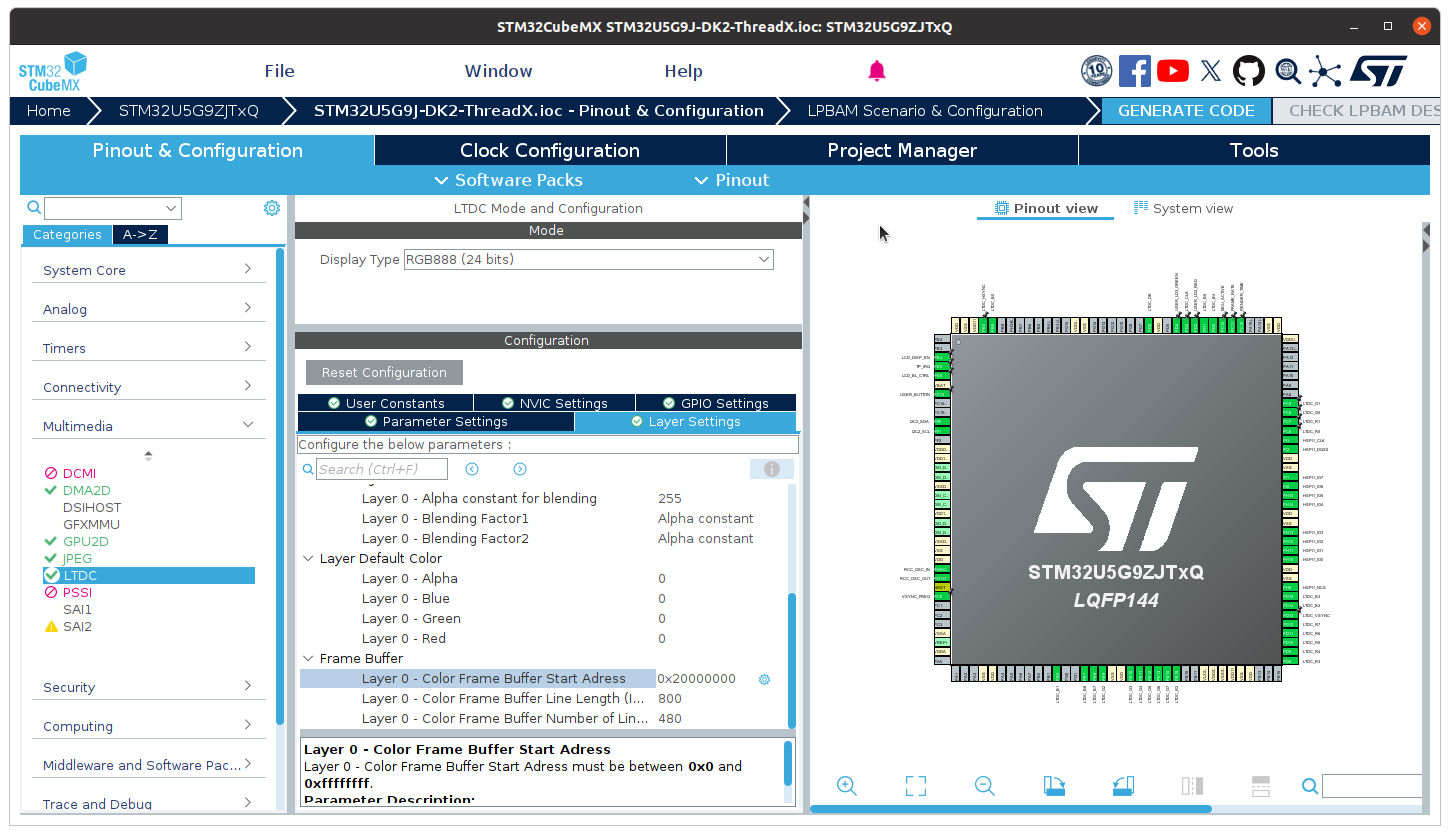STM32 LTDC Driver¶
Some STM32s have a specialized peripheral for driving displays called LTDC (LCD-TFT display controller).
Usage Modes With LVGL¶
The driver within LVGL is designed to work with an already-configured LTDC peripheral. It relies on the HAL to detect information about the configuration. The color format of the created LVGL display will match the LTDC layer's color format. Use STM32CubeIDE or STM32CubeMX to generate LTDC initialization code.
There are some different use cases for LVGL's driver. All permutations of the below options are well supported.
single or double buffered
direct or partial render mode
OS and no OS
parallelized flushing with DMA2D (only for partial render mode)
If OS is enabled, a synchronization primitive will be used to
give the thread a chance to yield to other threads while blocked,
improving CPU utilization. See LV_USE_OS in your lv_conf.h
LTDC Layers¶
This driver creates an LVGL display which is only concerned with a specific layer of the LTDC peripheral, meaning two LVGL LTDC displays can be created and operate independently on the separate layers.
Direct Render Mode¶
For direct render mode, invoke lv_st_ltdc_create_direct() like this:
void * my_ltdc_framebuffer_address = (void *)0x20000000u;
uint32_t my_ltdc_layer_index = 0; /* typically 0 or 1 */
lv_display_t * disp = lv_st_ltdc_create_direct(my_ltdc_framebuffer_address,
optional_other_full_size_buffer,
my_ltdc_layer_index);
my_ltdc_framebuffer_address is the framebuffer configured for use by
LTDC. optional_other_full_size_buffer can be another buffer which is the same
size as the default framebuffer for double-buffered
mode, or NULL otherwise. my_ltdc_layer_index is the layer index of the
LTDC layer to create the display for.
For the best visial results, optional_other_full_size_buffer should be used
if enough memory is available. Single-buffered mode is what you should use
if memory is very scarce. If there is almost enough memory for double-buffered
direct mode, but not quite, then use partial render mode.
To clarify what my_ltdc_framebuffer_address exactly is, it's the value of
pLayerCfg.FBStartAdress when the LTDC layer is configured using the STM32 HAL,
which is written to the CFBAR register of the LTDC layer peripheral.

Partial Render Mode¶
For partial render mode, invoke lv_st_ltdc_create_partial() like this:
static uint8_t partial_buf1[65536];
static uint8_t optional_partial_buf2[65536];
uint32_t my_ltdc_layer_index = 0; /* typically 0 or 1 */
lv_display_t * disp = lv_st_ltdc_create_partial(partial_buf1,
optional_partial_buf2,
65536,
my_ltdc_layer_index);
The driver will use the information in the LTDC layer configuration to find the layer's framebuffer and flush to it.
Providing a second partial buffer can improve CPU utilization and increase
performance compared to
a single buffer if LV_ST_LTDC_USE_DMA2D_FLUSH is enabled.
Linker Script¶
You should ensure the LTDC framebuffer memory is actually reserved in the linker script.
This is a file that normally has the extension .ld.
In the below example, 1125K is specified because the color depth is 24 (3 bytes per pixel),
the display width is 800, the display height is 480, and 1K means 1024 bytes.
3 × 800 × 480 ÷ 1024 = 1125. You should ensure the sum of the RAM entries
(FB_RAM + RAM) equals the total RAM of the device.
/* Memories definition */
MEMORY
{
FB_RAM (xrw) : ORIGIN = 0x20000000, LENGTH = 1125K /* single 24bit 800x480 buffer */
RAM (xrw) : ORIGIN = 0x20119400, LENGTH = 1883K
FLASH (rx) : ORIGIN = 0x08000000, LENGTH = 4096K
}
Display Rotation¶
The driver supports display rotation with
lv_display_set_rotation(disp, rotation) where rotation is one of
LV_DISP_ROTATION_90, LV_DISP_ROTATION_180,
or LV_DISP_ROTATION_270. The rotation is initially
LV_DISP_ROTATION_0.
The rotation is done in software and only works if the display was
created using lv_st_ltdc_create_partial().
LV_ST_LTDC_USE_DMA2D_FLUSH will be have no effect if rotation
is used.
DMA2D¶
LV_ST_LTDC_USE_DMA2D_FLUSH can be enabled to use DMA2D to flush
partial buffers in parallel with other LVGL tasks, whether or not OS is
enabled. If the display is not partial, then there is no need to enable this
option.
Additionally it is possible to mix layers that have color format on
LV_COLOR_FORMAT_ARGB1555 on top of LV_COLOR_FORMAT_RGB565
layers using the DMA2D.
It must not be enabled at the same time as LV_USE_DRAW_DMA2D.
See the DMA2D support.
Further Reading
You may be interested in enabling the Nema GFX renderer if your STM32 has a NeoChrom GPU.
lv_port_riverdi_stm32u5 is a way to quick way to get started with LTDC on LVGL.